Cloth of gold
Cloth of gold or gold cloth is a fabric woven with a gold-wrapped or spun weft—referred to as "a spirally spun gold strip". In most cases, the core yarn is silk wrapped (filé) with a band or strip of high content gold. In rarer instances, fine linen and wool have been used as the core.
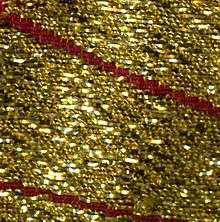
History
.jpg)
It is mentioned on both Roman headstones for women and in the Book of Psalms[1] as a fabric befitting a princess. The Ancient Greek reference to the Golden Fleece is seen by some as a reference to gold cloth. Cloth of gold has been popular for ecclesiastical use for many centuries. Under Henry VII of England, its use was reserved to royalty and higher levels of nobility.[2] It is also used today by companies such as Charvet for neckwear.
Few extant examples have survived in Roman provincial tombs. Later producers of cloth of gold include the Byzantine Empire and Medieval Italian weavers, particularly in Genoa, Venice and Lucca.[3] In the 14th century, cloth of gold made in China was called marramas.[4] A similar cloth of silver was also made. It is still made in India and Europe today.
Other
- Cloth of gold is not to be confused with various gold embroidery techniques that date to the early Middle Ages, though the type of goldwork thread called "passing" is identical to the weft thread of cloth of gold.
- Most modern metallic fabrics made in the West are known as lamé.
- Cloth of gold is a familiar name occasionally applied to the venomous Conus textile species of cone shell.[5]
- Tilsent is a luxurious silken cloth interwoven with flattened threads of gold or silver.[6]
Images
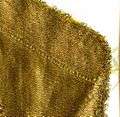 satin-weave cloth of gold, front
satin-weave cloth of gold, front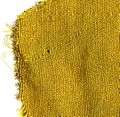 satin-weave cloth-of-gold, back
satin-weave cloth-of-gold, back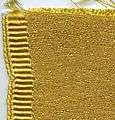 twill-weave cloth-of-gold, front
twill-weave cloth-of-gold, front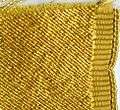 twill-weave cloth-of-gold, back
twill-weave cloth-of-gold, back
See also
References
- [Ps 45:14]
- Hayward, Maria (2009). Rich apparel: clothing and the law in Henry VIII's England. Ashgate Publishing. p. 172. ISBN 978-0-7546-4096-7.
- Jane Burns, E. (2009). Sea of silk: a textile geography of women's work in medieval French literature. University of Pennsylvania Press. p. 47.
- Lewandowski, Elizabeth J. The complete costume dictionary. Lanham, Md.: Scarecrow Press, Inc. p. 188. ISBN 9780810877856.
- "Cloth-of-Gold". Eyefetch. Archived from the original on 2012-02-10.
- Guy, John (2014). Henry VIII : the quest for fame. London: Allen Lane. p. 82. ISBN 9780141977126.
- The Roman Textile Industry and Its Influence. A Birthday Tribute to John Peter Wild. Edited by Penelope Walton Rodgers, et al.
External links
- Priest-Dorman, Carolyn (March 2002). "Some More Medieval Linen Weaves" (PDF). Medieval Textiles (31): 1, 5–7. ISSN 1530-762X.
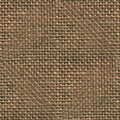
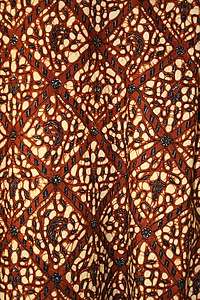
.svg.png)